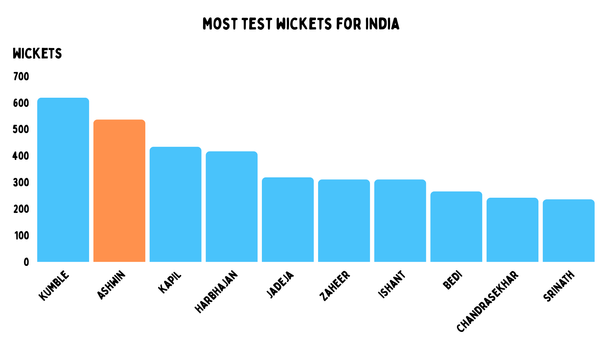How Rishabh Pant's six could spoil India's comeback
In one magnificent shot, India went from being in control of the game to hanging by a thread.

Rishabh Pant hit such a massive six today that it could cost India their shot at one of the greatest comebacks in Test cricket history.
I know that sounds ridiculous but stick with me. India collapsed for 46 runs—sorry for not giving a trigger warning. Then New Zealand piled on 400. Tim Southee alone outscored the entire Indian team, which is something that’ll always be funny.
But because of all that, the pitch became easier to bat on. India came out with a renewed approach. They scored 425 runs in 86.3 overs and lost only four wickets. There was still plenty of batting to come, they’d handled the second new ball well, and now it was all about being patient.
Rishabh Pant decided to swing for the fences on the third ball of the 87th over. And swing he did—perhaps as hard as he’s ever hit a ball. In one magnificent shot, India went from being in control of the game to hanging by a thread.
This Test was one of the most condition-dependent matches you’ll ever see. We knew the morning would bring some life back into it, but New Zealand had the old ball, and they bowled well without a breakthrough.
Sarfaraz and Pant settled in and punished the Kiwis, scoring at more than five runs an over. It looked like they were just knocking the ball around, yet the scoreboard kept ticking. The question now was whether India should start thinking about a declaration. After being in a difficult position, they were ahead in the game.
Will O’Rourke was spraying the ball everywhere, Ajaz Patel was sent back into hiding, and even Henry and Southee couldn’t apply any real pressure. New Zealand resorted to their part-timers, hoping for a miracle as the ball got softer.
The miracle never came. So it was all down to the new ball. Sarfaraz, who has never met a ball he didn’t want to hit behind point, finally stopped playing his dragonfly kisses and picked out cover. It gave New Zealand an opening, but Pant hardly noticed.
Even with Tim Southee getting some swing, Pant didn’t care. Sure, he was playing at half his usual manic, pixie-like energy because of his knee. But let’s be honest, who among us hasn’t been tempted to slog-sweep the new ball when the game gets tense?
That shot broke KL Rahul and Glenn Phillips—and it broke India.
But first, a quick history lesson. Remember the Ashes at The Oval, where there was a ball change? Conspiracy theorists said England had swapped in a remote-controlled ball straight from the devil’s workshop.
The truth, as always, is more mundane. There’s only a limited selection of balls, leftover from first-class matches, marked by overs. The umpires pick one that matches the wear and tear. That time, they probably grabbed one a bit too fresh, but it wasn’t exactly uncommon. Australia’s hopes went from alive to none in minutes. Sometimes the opposite happens—teams in control get a damaged ball replaced, and suddenly the runs flow.
There was a similar case at the Chinnaswamy earlier this year. MS Dhoni and Ravindra Jadeja were tearing apart RCB bowlers with a wet ball, which meant no slower deliveries could grip. They needed 63 from 24 balls to qualify for the finals—pretty tough you may say. Then the dew came in, and suddenly they were tearing up the ground. The equation was reduced to 17 off six balls.
Then Dhoni smashed a short one out into Cubbon Park, and the ball had to be replaced. CSK were going to qualify—the 11 runs seemed like nothing. Next delivery, Dhoni was out on the first slower ball that came out well, and another one followed. The 11 runs went from inevitable to impossible. The difference was that Yash Dayal now had a dry ball.
Back to Pant. He got down on his good knee and sent the ball flying over the Toblerone, over the fence, over the bottom tier, the upper deck, the roof—out of Chinnaswamy altogether.
At that point, India were ahead for the first time in the match. It felt like this was it—they were really going to pull it off. The new ball had been obliterated.
But then the umpires dug into their box and found another new ball. A second, second new ball. The problem for India was that this ball moved twice as much. And Pant was the first to find out.
His dismissal was likely due to a combination of factors—his knee was clearly bothering him, especially after he had pushed for a risky two the previous ball to reach his hundred. We all know how much he hates being stuck in the nineties.
But O’Rourke’s delivery was a nasty one—angled in from around the wicket, short of a length, and jagged sharply off the seam. Pant got bat on it, but the ball dropped back onto his stumps.
Before this, India had added 21 runs for one wicket in 6.3 overs with the second new ball. After Pant’s six, they lost 6 for 37 in just 13 overs.
The match isn’t over yet—India still have to bowl in the morning session. Defending a target of 107 seems unlikely, but with this pitch and these bowlers, anything could happen.
India had the game in their hands. Then Rishabh Pant hit that six, and the match slipped away. Somewhere outside the Chinnaswamy, there’s a ball sitting in a park that might’ve been India’s ticket to victory.



